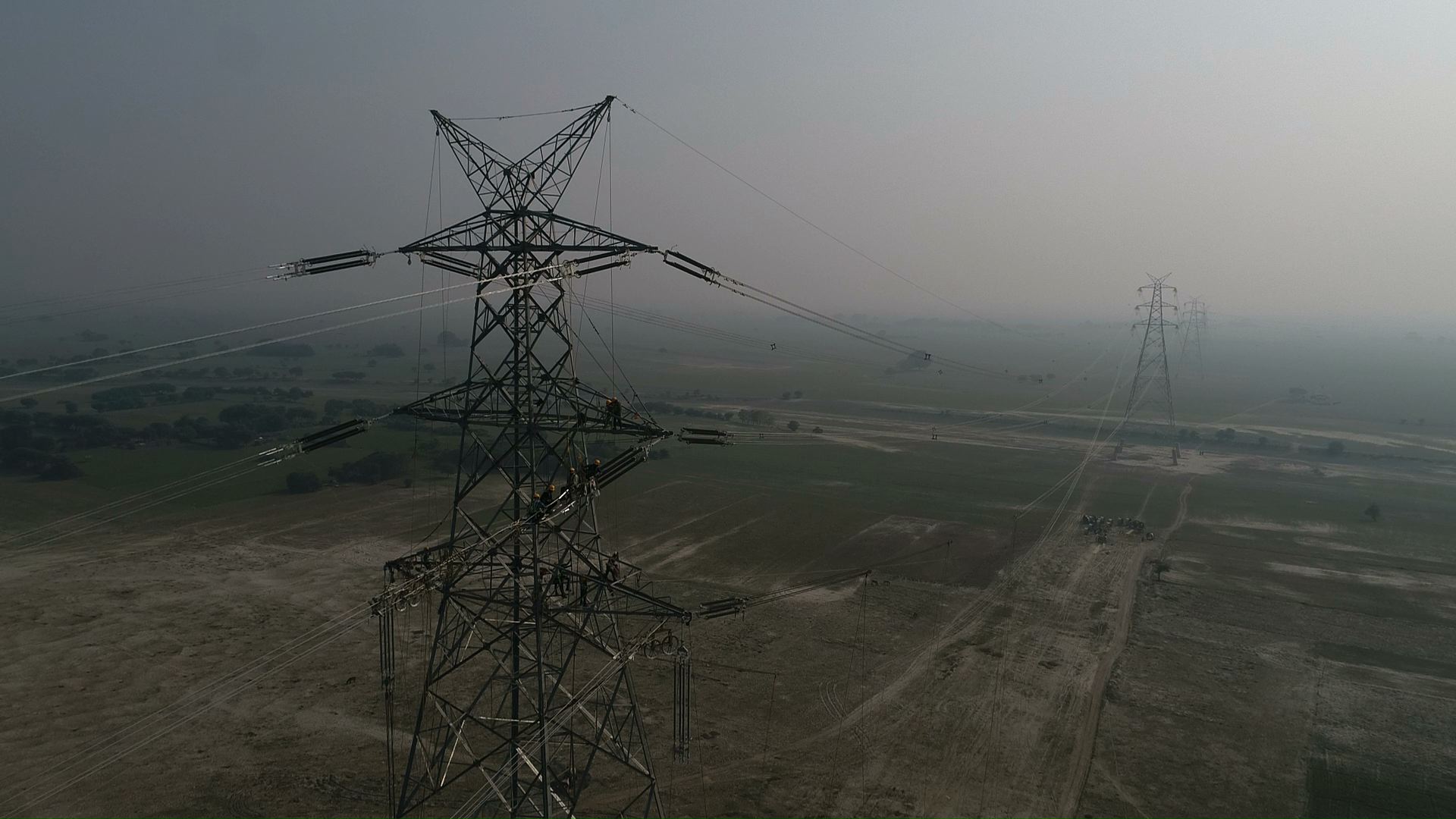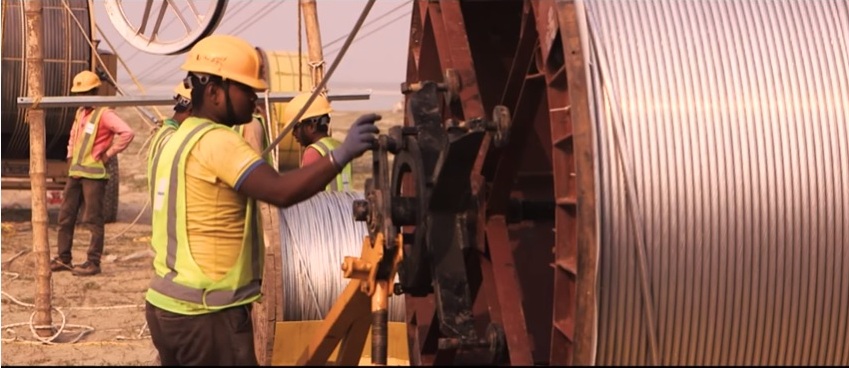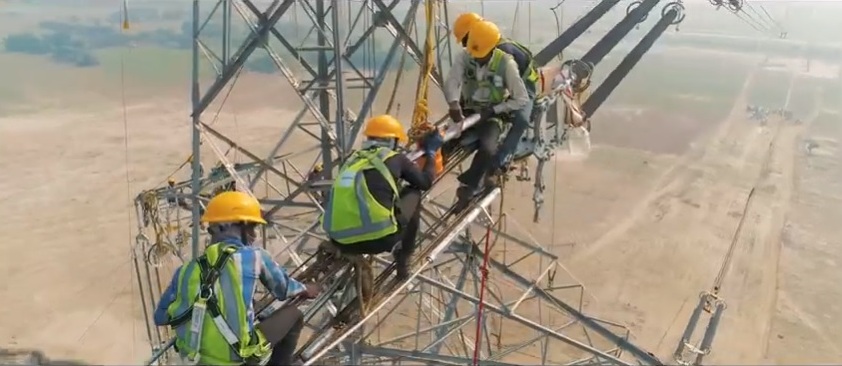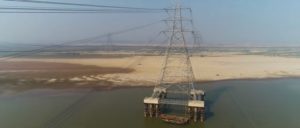Utilities are increasingly embracing technology-driven solutions: Sterlite Power
- November 19, 2020
 In this exclusive interview, we have Manish Agarwal, CEO, Solutions Business, Sterlite Power, explaining how Sterlite Power is harnessing cutting-edge technology to resolve India’s most intimidating power transmission-related challenges.
In this exclusive interview, we have Manish Agarwal, CEO, Solutions Business, Sterlite Power, explaining how Sterlite Power is harnessing cutting-edge technology to resolve India’s most intimidating power transmission-related challenges.
During ELECRAMA 2020, Sterlite Power launched the ACCC ULS Ganga conductor and showcased a video of a river crossing solution. Please discuss the highlighting properties of this conductor. Have you started promoting this to utilities?
It is a matter of immense pride for us that on October 30, 2020, we won ‘Gold’ at the IPMA Project Excellence Awards, for Project Ganga. This award is testament to Sterlite Power’s innovation and capability to overcome the toughest challenges in transmission, to deliver value to our client. Our endeavour has always been to customise solutions for our client and when something works very well, we can either scale up or replicate that solution elsewhere.
 Our innovative solution and product for Project Ganga, the ACCC ULS conductor, can be replicated in future for other such similar challenging long span reconductoring projects across rivers, or hilly terrains – where it may not be possible or feasible to have support structures in the middle. Currently, we are in talks with 2-3 utilities who have expressed interest in this solution in.
Our innovative solution and product for Project Ganga, the ACCC ULS conductor, can be replicated in future for other such similar challenging long span reconductoring projects across rivers, or hilly terrains – where it may not be possible or feasible to have support structures in the middle. Currently, we are in talks with 2-3 utilities who have expressed interest in this solution in.
The ACCC ULS Ganga, a solution developed by Sterlite Power, for the 400kV D/C quad transmission line on Purnia-Bihar Shariff, was specially designed and developed for a long span river crossing (1.1 km). The conductor was made ‘Ultra-low-sag’ to maintain adequate ground clearance as an active water channel was running below. It is light in weight so that it doesn’t exert any additional pressure on the towers that it was strung across from.
Another unique feature of this conductor is that it is has smaller diameter and higher current carrying capacity than a conventional conductor. Hence it exerts lesser tension on the towers. Along with developing this brand new conductor, Team Sterlite Power also had to design all new tools, hardware and accessories for it.
The solution for Project Ganga was executed under immensely challenging conditions. The project had to be executed across an active water channel and hence men, machine and material were moved on floating barges and ferries. Work took place on floating platforms, at substantial heights over the river, where even the smallest mistake would prove to be costly. The teams had to think on their feet, customising solutions as they went along. This project is truly reflective of our commitment to our organisation’s core purpose: “To empower humanity by addressing the toughest challenges of energy deliver’ and our core value of Innovation.”
Utilities are increasingly embracing technology driven modern solutions to retrofit existing infrastructure. Kerala is a shining example to this effect.
Central Electricity Authority (CEA) has consistently been advocating the use of high-performance conductors (HPC) to improve the efficiency of India’s power transmission grid. Given that Sterlite Power has done extensive work for state power utilities, how do you see their general inclination towards modern solutions?
 That’s correct. The CEA has encouraged Utilities to adopt HPC’s for reconductoring and upgradation of existing transmission infrastructure in view of the overall benefits from time, space and capital perspective. In its ‘Manual on Transmission Planning Criteria’ (January 2013), CEA states, High Performance Conductors (HPC) enable utilities in designing efficient power transmission systems. Transmission Planners (both Central Transmission Utility & State Transmission Utilities) have been mandated to consider up-gradation of the existing AC transmission lines to higher voltage, using the same RoW and re-conductoring of existing AC transmission lines with higher ampacity conductors. This has also been reiterated in CEA’s latest guidelines for “Rationalized Use Of High Performance Conductors” (Feb 2019), where it observed that HPC can address issues like growing congestion in existing corridor of transmission / distribution network and can help in enhancement of power flow per unit Right of Way (RoW). Due to the above regulatory push, CTU and several STUs have made the switch to high performance conductors in existing lines and new lines. The recent Green Energy Corridors projects of Rs.15,000 crore under TBCB route have also included High Performance Conductors (HPC) in a big way.
That’s correct. The CEA has encouraged Utilities to adopt HPC’s for reconductoring and upgradation of existing transmission infrastructure in view of the overall benefits from time, space and capital perspective. In its ‘Manual on Transmission Planning Criteria’ (January 2013), CEA states, High Performance Conductors (HPC) enable utilities in designing efficient power transmission systems. Transmission Planners (both Central Transmission Utility & State Transmission Utilities) have been mandated to consider up-gradation of the existing AC transmission lines to higher voltage, using the same RoW and re-conductoring of existing AC transmission lines with higher ampacity conductors. This has also been reiterated in CEA’s latest guidelines for “Rationalized Use Of High Performance Conductors” (Feb 2019), where it observed that HPC can address issues like growing congestion in existing corridor of transmission / distribution network and can help in enhancement of power flow per unit Right of Way (RoW). Due to the above regulatory push, CTU and several STUs have made the switch to high performance conductors in existing lines and new lines. The recent Green Energy Corridors projects of Rs.15,000 crore under TBCB route have also included High Performance Conductors (HPC) in a big way.
Utilities are increasingly embracing technology driven modern solutions to retrofit existing infrastructure. Kerala is a shining example of its vision and planning in this regard with the biggest intra-state strengthening of transmission infrastructure taking place through upgrade/uprate as part of its Transgrid projects.
Over last few years, Delhi has uprated around 50 per cent of its 220kV network with a view to have a ‘Zero generation scenario’ grid plan and rely on imported power. The city will also now have to gear up for upgrade of its Substation’s and lines on critical corridors, a case like Kerala. I am pleased to share with you that Sterlite Power has partnered with Delhi in this transition and around 80 per cent of the uprate projects have been executed by us.
Today in India, at least states have opted to uprate their existing transmission infrastructure with innovative high-performance products and solutions. Sterlite Power has been closely partnering with many of these Utilities in understanding their concerns, proposing and implementing bespoke solutions. We have a robust team on Power Systems – Technology, New Product Development, end to end, 360° solutions. We play a consultative role with our customers and stay closely engaged and accommodate their requirements throughout the cycle, from selling to delivering on the solution.
Please cite a few recent examples where Sterlite Power’s innovative solutions conductor and technology has helped Transcos make their grids efficient.
 As thought leaders in the industry, recently, we had the honour and privilege of presenting two important papers on our innovative solutions and technologies -Live Line Reconductoring and Dynamic Line Rating, at CIGRE’s e-session 2020. This is a prestigious global forum in the international fraternity of power systems experts, for exchange of knowledge, ideas and experiences with technology and solutions.
As thought leaders in the industry, recently, we had the honour and privilege of presenting two important papers on our innovative solutions and technologies -Live Line Reconductoring and Dynamic Line Rating, at CIGRE’s e-session 2020. This is a prestigious global forum in the international fraternity of power systems experts, for exchange of knowledge, ideas and experiences with technology and solutions.
In the case of live-line reconductoring, we undertook a pilot project in Bangalore’s electronic city by uprating a 66kV line, in a congested area, without taking a shut down. This project was beneficial to the utility, as the power ampacity on that line was enhanced 2x times in the same corridor, using the existing infrastructure. Additionally, from a social impact perspective, since no shut down was taken and there was no extensive traffic blocking in the area, locals and the business community, were not inconvenienced. Hence, is a pioneering solution, that demonstrates the options to uprating congested lines with ‘Zero-shut down’, in congested cities.
SmartValves is a cutting-edge technology. They are intelligent ‘valves’ that allow optimal utilization of existing transmission capacity, enhancing grid flexibility.
Technologies like Dynamic Line Rating (DLR) and Smart Valves will enable utilities to have real time assessment and control of power flows. DLR helps in monitoring and optimization of transmission line capacity, helps monitor the sag and enhances reliability. DLR can be used to decongest lines whenever necessary. It is simple to use, easy to install and a reusable solution. The use of DLR provides real time capacity availability understanding. This helps in managing congested lines and provides real time data and forecasting for new lines.We conducted a pilot project with the installation of DLR in Kerala, on a 40-year-old 66kV line, which has different conductors on different sections. The DLR has helped the customer use the line for higher power as compared to static limits.
SmartValves are also something that utilities have been expressing an interest in. It is a cutting-edge technology, an intelligent ‘valve’ that allows optimal utilization of existing transmission capacity and enhances grid flexibility. As generation and demand change, circuits can become unequally loaded. Some lines reach their maximum capacity while others are well below their limits. SmartValve technology can unlock this system capacity by evenly balancing power flows.
Fiberization of transmission networks to provide reliable data and communications infrastructure is also something that the government has been emphasizing. Sterlite Power is one of the largest EPC and solutions providers in India, for fiberization of existing transmission infrastructure on brownfield projects enabling robust grids and safe, healthy and resilient telecom infrastructure, executing ~12,000 km of Fiberization on charged lines. Recently, we also launched a pioneering innovation – SkyrobTM –a semi-autonomous robot developed to ensure safety of ‘high-risk’ operations involved in the installation, inspection and maintenance of OPGW on high voltage transmission lines under energized conditions.
CTC Global has been our trusted partner since December 2010 and we remain aligned to our common goal of providing customers with the best and proven technologies.
How is your technical collaboration with CTC Global (for ACCC conductors) progressing? Could you give us a rough idea of the volume of ACCC conductors deployed in the Indian transmission network so far?
Sterlite Power was first to bring the ACCC technology to India. Over the last decade, majority of the uprates in the country have happened using this globally proven technology. CTC Global is a global leader in this technology and has supplied 100,000 km of HPC internationally to 50+ countries. Their global market share in this business is 95 per cent (excluding China). In India, around 20 states are using HPC technology and Sterlite Power is working with most of them. CTC has been our trusted partner since December 2010 and we remain aligned to our common goal of providing customers with the best and proven technologies. We have maintained a relentless focus on changing customer buying behaviour from least cost component to best value solution. CTC has 22 partners globally and in India 3 partners. We are arguably the largest ACCC manufacturers, both, in India and internationally. While there are other emerging technologies, Sterlite Power remains committed to offering the best to the customer, in terms of tried and tested technologies, which we can bet on.
Please take us through the various high-performance conductors made by Sterlite Power.
 Sterlite Power offers the complete suite of products under HPC. They are all type-tested and we have a good track record on supplies. We are the world’s leading manufacturer and supplier of this product. These conductors range from GAP, DULL (Non Specular), ACSS, ECO, AL59 / 1120 Allloy, TASCR, STACIR, STACIR and ACCC (Carbon Composite).
Sterlite Power offers the complete suite of products under HPC. They are all type-tested and we have a good track record on supplies. We are the world’s leading manufacturer and supplier of this product. These conductors range from GAP, DULL (Non Specular), ACSS, ECO, AL59 / 1120 Allloy, TASCR, STACIR, STACIR and ACCC (Carbon Composite).
High Performance Conductors (HPC) are the solution to enhancing power transmission capacities on existing or new transmission lines, where there is a need to respond to the exponential demand for power. This solution helps decongest the transmission network in existing corridors. These conductors run at higher temperatures than conventional ones and broadly are of 03 types.
Type 1: Conductors composed of a steel core and an envelope for which the high temperature effects are controlled by means of thermal resistant aluminium (ZTAL/STAL) alloys (e.g. GAP, STACIR)
Type 2: Conductors composed of a steel core and an envelope for which the high temperature effects are controlled by means of annealed aluminium or aluminium alloy (e.g. ACSS)
Type 3: Conductors composed of a non-metallic core, and an envelope for which the high temperature effects are controlled by means of annealed aluminium or aluminium alloys (e.g. ACCC)
We have supplied HPC to Latin America, Europe and the Middle East and are focused on them as there is high demand.
How has been the response to Sterlite Power’s high-performance conductors in the global market? Which countries/regions represent your biggest markets?
We have supplied HPC to Latin America, Europe and the Middle East and are focused on them as there is high demand. There is a lot of interest in HPCs that we are seeing in North America and South America, both for new lines and existing ones. Globally Sterlite Power is a leading provider of HPC Solutions. Despite the COVID19 pandemic and lockdown restrictions we have been receiving inquiries from leading international Utilities. There is always a lot of interest from SAARC countries as well. In developing countries like Bangladesh around 50 per cent of new transmission lines that are approved and under implementation are on high ampacity and low loss products, while this stands at around 30-35 per cent in Indonesia.
You have always said that Sterlite Power’s Solutions Business main objective is to optimize both time and cost—the two critical parameters of any infrastructure project. Please discuss how selection of the right conductor can help achieve this objective in a power transmission project?
Instead of building a new line if you an uprate an existing corridor with an HPC conductor, then the capacity increase can be achieved in 3-6 months compared to 1.5 to 2 years for building a new transmission line. And this can be done at a much lower cost. We work with the customer to support them on the right conductor selection from a ‘total cost of ownership’ perspective rather than just the upfront conductor cost. Through our power system’s study capability, we can even look at the power carrying capacity requirements of transmission lines for meeting the load requirements for next few years and assist the customers to make the right decision.
Not choosing the right conductor and the right line capacity at the right stage can lead to the line reaching to its full capacity very soon and this may call for reinvestment in a new line or capacity enhancement of the existing line. This can increase the burden on the utility from time, space and capital perspective, if the right capacities have not been planned upfront.


